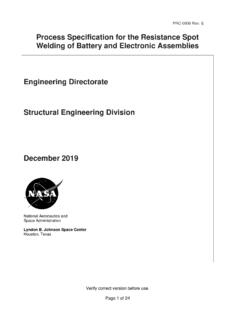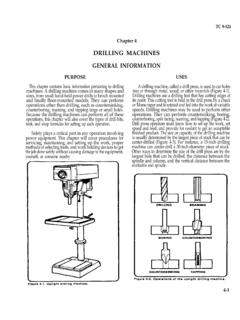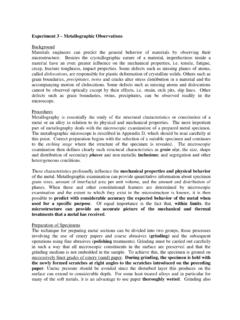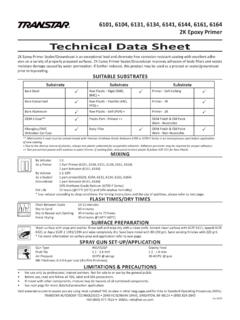Transcription of Process Specification for Dry-Film Lubricant Application
1 PRC-8001 Rev. E. Process Specification for Dry-Film Lubricant Application Engineering Directorate Structural Engineering Division January 2013. National Aeronautics and Space Administration Lyndon B. Johnson Space Center Houston, Texas Verify correct version before use. Page 1 of 13. PRC-8001 Rev. E. Process Specification for Dry-Film Lubricant Application Prepared by: Signature on file 1/22/13. Daila Gonzalez Date Materials and Processes Branch/ES4. Signature on file 1/22/13. Approved by: Rachel Kamenetzky Date Acting Branch Chief Materials and Processes Branch/ES4. REVISIONS. VERSION CHANGES DATE. -- Original version 5/14/96. A New format, title change, author change, re-wrote section 7/26/99. , expanded section , specified 220 mesh alumina for grit blasting Ni alloys and stainless steels, made burnishing standard, revised storage time limits in section B Changed EM references to ES, clarified passivation 11/14/02.
2 Requirements for nickel-based and stainless steel alloys. Verify correct version before use. Page 2 of 13. PRC-8001 Rev. E. -C Updated time and temperatures for curing Everlube 811 and 3/27/2009. Everlube 812, added Ecoalube 642, added processing requirements for copper-based alloys, added notes to designers in section , added clarifications related to in- Process rework, burnishing, and thickness measurements, reordered subsections of section and added section on dry film Application requirements, provided exception to thickness verification for threaded fasteners, updated military specifications for dry film lubricants , updated surface pre- treatment for aluminum alloys, removed requirement for phosphate coating of steel alloys, clarified masking tape requirements, disallowed thickness measurement by micrometer.
3 Minor grammatical changes; removed the statement For D 05/12/2010. best adhesion, hard anodize (Type III) with a water seal is preferred from section and subsection ; added sentences to section stating that 1) the use of a teflon- impregnated anodic coating is preferable for aluminum alloy components, 2) Tufram H is generally applied to anodized aluminum alloy components, instead of applying a Dry-Film Lubricant post anodizing, and 3) blasting is not required when applying Tufram H to an anodized aluminum alloy component; added sentence to section and subsection specifying to glass bead blast aluminum alloy components post anodizing if applying Dry-Film lubricants ;. changed title on subsection ; added third paragraph to subsection specifying the use of size 10 (200 mesh).
4 Glass beads to blast aluminum alloy surfaces with a 20lb blast as a surface pretreatment; added sentence to subsection specifying that rework shall include stripping the anodic coating completely and re-applying it, glass bead blasting, and solvent cleaning for aluminum alloy surfaces that exceed the time limit stated in subsection Updated signature page, updated curing times to 300 F . E 01/22/2013. 25 F for Everlube 620C on all alloys in section (375 F . 25 F over cures phenolic based resin making dry film harder and less effective as a Lubricant ). Verify correct version before use. Page 3 of 13. PRC-8001 Rev. E. SCOPE. This Process Specification establishes the engineering requirements for the use of Dry-Film lubricants that are applied to metallic parts used in flight hardware manufactured by JSC or provided to JSC by an outside vendor.
5 APPLICABILITY. This Process Specification applies to phenolic resin-bonded (Everlube 620C), silicate-bonded (Everlube 811, Everlube 812) and epoxy-bonded (Ecoalube 642, Tiolube 460) Dry-Film lubricants . Specifically, it addresses the brush or spray Application of these lubricants and their cure times at elevated temperatures. USAGE. This Process Specification shall be called out on the engineering drawing by identifying the surface(s) to be coated and using a drawing note that identifies the Lubricant . One example of the standard callout is: APPLY { Lubricant designation} Dry-Film Lubricant PER NASA/JSC PRC- 8001. This Specification controls the curing time/temperature (section ) and the thickness (section ) for the Dry-Film lubricants listed.
6 For lubricants not listed in this Specification , the material, thickness, and curing time/temperature shall be specifically called out on the drawing in a manner similar to the following example: APPLY { Lubricant designation} Dry-Film Lubricant PER NASA/JSC PRC- 8001, COATING THICKNESS to INCHES. CURE AT. {temperature} + 10 F FOR {time} HOURS. Burnishing of the cured Dry-Film coating is standard. If a burnished coating is not desired, a note of DO NOT BURNISH shall be included on the drawing. It is difficult or impossible to apply Dry-Film Lubricant with a uniform thickness on internal surfaces and radii. Functional surfaces shall be marked for coating. Other surfaces should be flagged as OVERSPRAY ACCEPTABLE or NO.
7 Dry-Film ON THIS SURFACE . The Dry-Film lubricants that are standard for this Specification consist of molybdenum disulfide (MoS2) particles or MoS2/graphite particles that are held together by a binder. Everlube 811 and Everlube 812 have a silicate binder, which make them good in specialized applications, such as when liquid oxygen Verify correct version before use. Page 4 of 13. PRC-8001 Rev. E. (LOX) compatibility is required. However, Dry-Film lubricants with silicate binders are many times not a good choice for spaceflight hardware because they are not as durable as Dry-Film lubricants with phenolic resin-based binders, such as Everlube 620C. Tiolube 460 and Ecoalube 642 use epoxy-based binders and are often used for ground support equipment or situations such as on the threads of bolts that are not planned to be removable.
8 The Dry-Film Lubricant and its material Specification (if applicable) shall be called out in the parts list similar to the following: Part Number Description Material Specification Everlube 620C Dry-Film Lubricant MoS2 AS5272 Type I. with resin binder Everlube 811 Dry-Film Lubricant MoS2/graphite MIL-PRF-81329. with silicate binder Everlube 812 Dry-Film Lubricant MoS2 MIL-PRF-81329. with silicate binder Tiolube 460 Dry-Film Lubricant MoS2 AS5272 Type II. with epoxy binder Ecoalube 642 Dry-Film Lubricant MoS2 AS5272 Type II. with epoxy binder The Everlube and Ecoalube products are produced by Metal Improvement Co. and Tiolube products are manufactured by the Tiodize Corporation. When considering applying a Dry-Film Lubricant to an aluminum alloy component, a materials engineer should be consulted, since it is not usually the best design solution.
9 The use of a teflon-impregnated anodic coating is preferable. For example, Tufram H is generally applied to anodized aluminum alloy components, instead of applying a Dry-Film Lubricant post anodizing. Blasting is not required when applying Tufram H to an anodized aluminum alloy component. However, if a Dry-Film Lubricant must be applied to an aluminum component, it must be anodized per PRC-5006 prior to glass bead blasting the region where the Dry-Film Lubricant will be applied. For nickel-based and stainless steel alloys, the entire component must be passivated per PRC-5002 prior to grit blasting the region where the Dry-Film Lubricant will be applied. Passivation can be waived only if every surface of the component will have Dry-Film Lubricant applied.
10 When this is the case, functional surfaces should be designated on the engineering drawing. More detailed requirements for surface preparation are found in section Verify correct version before use. Page 5 of 13. PRC-8001 Rev. E. Dry-Film lubricants are mechanically bonded to metal surfaces and these surfaces must be roughened to promote Lubricant adhesion. This is normally accomplished by abrasive blasting or glass bead blasting of the surface before coating. For best adhesion and wear resistance, the pre-coating surface roughness should normally be specified on the engineering drawing to be 32 rms (nominally) or rougher. Usually this is accomplished with a drawing note pointing to the specific surface involved and indicating the surface roughness.










